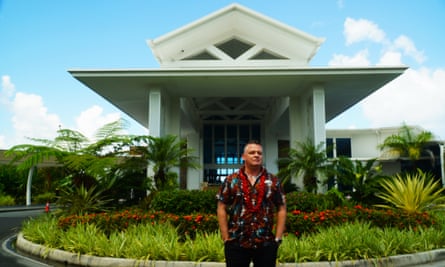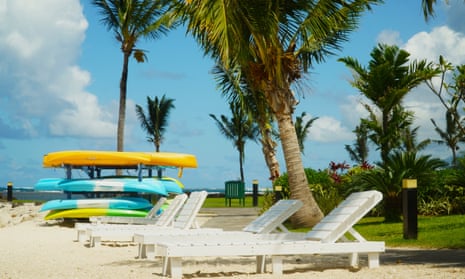For most visitors to the exclusive resort on Taumeasina Island near Apia, Samoa, it is the golden sands and tropical waters that appeal. But for others, the real attraction may be the resort’s staff themselves.
Business people from Australia and New Zealand often stay at the resort while visiting Samoa in search of workers to recruit for seasonal jobs back home.
But nowadays when these guests arrive, Tuiataga Nathan Bucknall, the general manager of the resort, has to “bite his tongue”. They may be valued customers, but they also might be there to hire his staff from under his nose.
Over the past year, Bucknall has lost nearly 60 staff – about one-third of the number usually employed at the resort – to seasonal work programs in Australia and New Zealand, in a sign of a record exodus of workers from Samoa to meet growing demand for Pacific labour.
To keep services running, Bucknall has had to hire a large number of untrained staff at short notice.
“The sad thing is we’ll get them trained and then some seasonal worker program will pick them up and we’ll have to start again,” he says. “That’s the reality of what’s happened in the last year. We’ve become like a breeding ground for seasonal workers.”
Bucknall is raising salaries in a bid to get staff to stay. “But you know, there’s certainly no way that we can match what there is in Australia [and] New Zealand.”
The loss of seasonal workers is a regular and usually welcome occurrence for Samoa, which relies on the receipt of remittances from citizens working abroad, equivalent to 29% of GDP according to World Bank data.

But last year, departures reached record levels, with more than 6,600 Samoans recruited for seasonal work in Australia and New Zealand – more than double the number leaving before the pandemic – according to data analysed by the Development Policy Centre.
This trend shows little sign of slowing. Last year, New Zealand and Australia both expanded their seasonal work schemes. Although traditionally aimed at low or unskilled workers, Australia’s Pacific Australia Labour Mobility (Palm) scheme is now targeting skilled workers in the hospitality, aged care and tourism sectors.
“The scheme was initiated to serve the unemployed, especially in the rural areas. The problem we have now is that a lot of people who are currently employed are applying and a lot of them are from the urban area. Then they get accepted and quit their jobs,” says Clyve Westerlund, the business development manager of prominent Samoan firm Ah Liki Wholesale in Apia.
Ah Liki Wholesale has lost 20-25% of its workers over the past two years, Westerlund says, compared with about 5% annually before the pandemic. He says “virtually the entire private sector” has been affected, unable to compete with wages offered abroad.
“A lot of the new guys might only work for one month and then all of a sudden they go on the scheme. It seems like they’re filling in the time by working locally, but the ultimate goal is to go overseas to pick fruit and veggies,” Westerlund says.
While the recent expansions of Australia’s and New Zealand’s seasonal work schemes have been pitched by Canberra and Wellington as a win-win, the response has been mixed in Pacific capitals.
The Samoan government began a review into the country’s participation in the schemes last year, before temporarily suspending departures in December.
The acting prime minister, Tuala Iosefo Ponifasio, singled out the Australian government’s failure to consult Apia before announcing a new visa category in October, which will see up to 3,000 people across the Pacific and Timor-Leste invited to apply for permanent residency in Australia.
“There has been no communications with our government on this. They will start by taking our workers for three years and I believe they will not return.

“They will take our workers in [the] tourism industry, hospitality, teachers and police officers and will take our matai [chiefs] and people serving the village,” Tuala told parliament in Apia.
“They’re leaving a very big gap back home,” says Prof Regina Scheyvens of Massey University’s Institute of Development Studies of the seasonal worker programs.
“For too long seasonal labour schemes … have focused on alleviating our labour shortages without thinking sufficiently about whether we might be impeding long-term self-determined development in the Pacific.
“If we’re going to open up opportunities to Pacific peoples for the longer term, we have to take a good hard look at what else has been done to support the growth of Pacific Island economies themselves, so that their governments don’t have to resort to exporting their labour as a major source of revenue and can instead retain their own people.”
Back in Apia, Westerlund accepts there are “no easy solutions. But I would suggest that we seriously consider protecting the local labour market first, before we start sending our people overseas.”

Comments (…)
Sign in or create your Guardian account to join the discussion